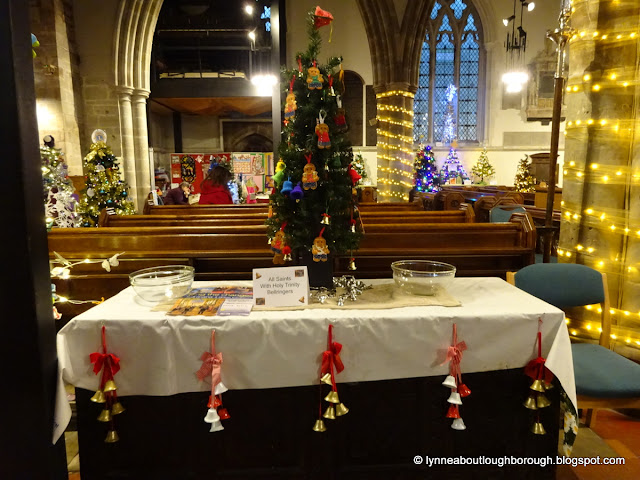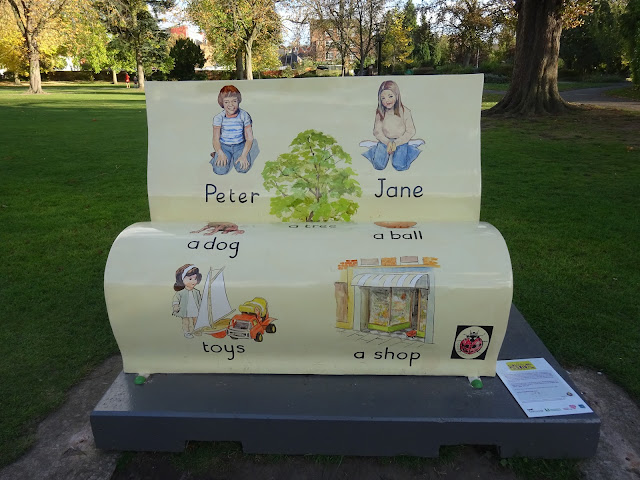So, as 2023 comes to a close, I shall do my usual review of the year on the blog!
 |
| Hoarding going up around the HSBC in Market Place, December 2023 |
The 10th most popular post this year was one I wrote about my June visit to Garendon Park, when we were shown around the area near the obelisk.
To coincide with the launch of my book about Loughborough pubs, in November I posted about pubs as meeting places, which proved to be the 9th most viewed post of the year.
At the beginning of the year, it was announced that the Canal and Rivers Trust would be improving the canal towpath, between the old Herbert Morris factory and the basin, so my post about a walk along the canal towpath was the 8th most popular of the year.
For International Women's Day, I presented you with the story of two sisters, Avery and Ida Woodward, who were daughters of a teacher at the Loughborough Grammar School. One sister was a lecturer at Royal Holloway College, the other was influential in the field of X-ray crystallography. This post was the 7th most read of the year.
In February 2023 I was lucky enough to have a guided tour around Chesterton House, a building which had once been home to the first girls' grammar school in the country. It was also once home to the Warner family who owned the shop on the corner of Fennel Street. This was a popular post whose position in the chart was 6th, and I was grateful to be able to provide the post which gave an update on the entry that I had included in 'Loughborough in 50 Buildings'.
Then, in March 2023 I happened to be walking along Packe Street, and noticed that there was an open event happening at the Generator building. Not being able to resist, I walked through the open door - and I'm glad I did because I had a wonderful time looking around the building, and because you clearly enjoyed reading my post about it, putting this article into 5th position!
Again, at the beginning of 2023, I looked back over some of the changes that happened in Loughborough during 2022 - and goodness me, there were a lot of changes, to industrial, retail, and residential buildings, from demolitions to rebuilds, and renovations! Mostly photos, this post came in 4th.
I was very lucky to have quite a number of guest bloggers during 2023, and I am so pleased that one of these made it to 3rd position! 'Warner's Corner' described the shop that so many people from Loughborough remember - particularly its orange sunscreens - and the family that made the business.
It's hardly surprising that a pictorial post about the fire at Loughborough's HSBC, in Market Place, came in 2nd place. The repairs to the building are going to take 18 months to 2 years, but it's nice to see the temporary, decorative hoarding that has recently gone up.
So, the most viewed post of 2023 is about my first visit of the year to Garendon Park. This included photos of some of the well-known, and less well-known structures on the estate.
Incidentally, I actually wrote three posts about my visits to the Garendon Park Estate, and the second of these came in at position 13.
Looking at the popularity in 2023 of all the blog posts I've ever written, a few older posts have made the top 10, including a piece about the Derby Road Co-op building, and the Loughborough Union Workhouse.
Highlights of the year for me include hosting a variety of guest blogs during August 2023, when the blog celebrated its 10th birthday; attending the local history fair at Beaumanor Hall; having a stall at the Carillon100 event, and the publication of 'Loughborough Pubs'.
What I am most grateful for though, is you! Thank you so much for reading the blog during 2023, and thank you for your comments and questions! You can find a complete list of blog posts here! I hope to be able to continue the blog into 2024, but for now, I must sign off and ring in the New Year!
Thanks again,
Lynne
____________________________________
Posted by lynneaboutloughborough
With apologies for typos which are all mine!
_______________________________________________
Thank you for reading this blog.
Copyright:
The copyright © of all content on this blog rests with me, however, you are welcome to quote passages from any of my posts, with appropriate credit. The correct citation for this looks as follows:
Dyer, Lynne (2023). Christmas Tree Festival 2023. Available from: https://lynneaboutloughborough.blogspot.com/2023/12/happy-new-year.html [Accessed 31 December 2023]
Take down policy:
I post no pictures that are not my own, unless I have express permission so to do. All text is my own, and not copied from any other information sources, printed or electronic, unless identified and credited as such. If you find I have posted something in contravention of these statements, or if there are photographs of you which you would prefer not to be here, please contact me at the address listed on the About Me page, and I will remove these.
External Links:
By including links to external sources I am not endorsing the websites, the authors, nor the information contained therein, and will not check back to update out-of-date links. Using these links to access external information is entirely the responsibility of the reader of the blog.
Blog archive and tags:
If you are viewing this blog in mobile format, you will not be able to easily access the blog archive, or the clickable links to various topics. These can be accessed if you scroll to the bottom of the page, and click 'View Web Version'. Alternatively, there is also a complete list of posts, which when clicked will take you to the page you are interested in.
Searching the blog:
You can search the blog using the dedicated search box that appears near the top of the blog when viewed in the web version. Alternatively, you can search using your usual search engine (e.g. Bing, Google, DuckDuckGo etc.) by following this example:
site: https://lynneaboutloughborough.blogspot.com/ “Radmoor House”
NOTE – the words you’re actually looking for must be in “” and the first of these must be preceded by a space
Thank you for reading this blog.
Lynne






















.JPG)










